|
- Catalog (in stock)
- Back-Catalog
- Mail Order
- Online Order
- Sounds
- Instruments
- Projects
- History Face
- ten years 87-97
- Review Face
- our friends
- Albis Face
- Albis - Photos
- Albis Work
- Links
- Home
- Contact
- Profil YouTube
- Overton Network
P & C December 1998
- Face Music / Albi
- last update 03-2016
|
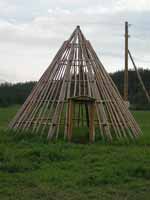
Tshum
|

Tshum
|

Tshum
|
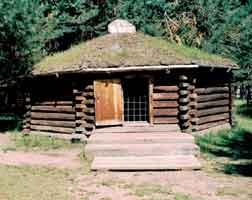
Burjathouse
|
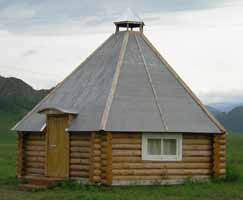
Summerhouse
|
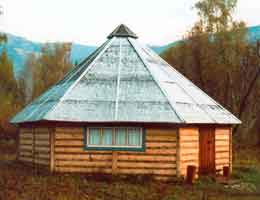
Summerhouse |
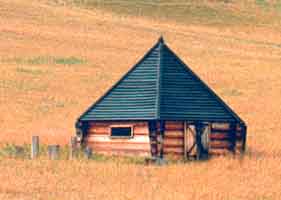
Summerhouse |
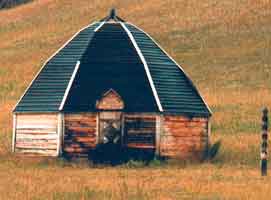
Summerhouse |
| - see more information about - Monuments of Altaian peasant architecture |
|
Development of nomadic dwellings

|
| - first two rows: |
| - Tshum of the Tungus * (Tshum, a tent of nomadic peoples which can be quickly assembled and taken down and which can be easily transported; in former times it was coated with the bark of a tree, nowadays it is covered with animal skins). |
| - half-tshum |
| - Early nomadic period, approx. 6th century after Christ (with a filt coating made of sheep's wool). |
| - lowest row |
- Modern construction of yurts = round tent or Mongolian = ger (dwelling or home of the nomads. A dwelling with a filt coating made from sheep's wool which can be quickly assembled and taken down and which can be easily transported). These traditional dwellings are not only typical for the Mongolian population, they are also used by all nomadic tribes in the entire area of Central Asia, in Southern Siberia and in the area up to the Great Wall. Since Modern Age, there have also existed summer houses that have been erected from wood by Turk tribes who have settled in Southern Siberia in the High-Altai area.
|
|
- *Tungus is an archaic name for the Evenks and, in part, for the Evenks; it denominates in general all peoples speaking the Manchurian-Tungusic language. It is, however, also a comprehensive term for all peoples, ethnic groups and groups of peoples whose ancestors used this language. They live in regionals groups or clans here and there in the Siberian Taiga (woodland) and the Tundra (treeless steppe beyond the Arctic treeline), and they are also called "the little people" in Siberia. They live from reindeer breeding, fishing and hunting. Also in Mongolia and in the People's Republic of China, there are some descendants of those Tungus people speaking the Manchurian-Tungusic language. Some of this nomads are still involved in reindeer breeding. In the Middle Siberian part of the grass land and in the mountain regions, the people even at that time pursued horse and cattle breeding.
The Evenks and the Tungus, respectively, populated great parts of Siberia in the 11th and 12th century.
Today their autonomous area is restricted to the tributary of the River Jenissey near the Rivers Lower Tunguska and the Stony Tunguska, a mountainous and sparcely populated mountain area in Central Siberia. Their religion is, apart from Buddhism, also strongly dominated by shamanism, the rites of which are nowadays in practice again. Here, the form of the shamanistic animism, this is, the belief in animate nature, hence the existence of spiritual beings, is cultivated. Contact with these beings is established by means of drums and speech songs.
|
|
|
| Seating arrangement
|
Furniture

|
| A |
Iron oven with outlet pipe
|
| B |
Wooden chest for arming
|
| C |
Low table for eating
|
| D |
Stool
|
| E |
Beds
|
| F |
Storage chests
|
| G |
Storage chest with altar thereon
|
| H |
Cradle board for cooking utensils
|
| I |
Water tank
|
| J |
Leather bag for airag
|
| K |
Rack for saddles |
|
|
|
Interior design of a Kazakh ger - far right a "Kiis-Uj" - Kosh-Agach High-Altai
|
|
|
|
|
Construction elements of a Mongolian ger
|
|
|
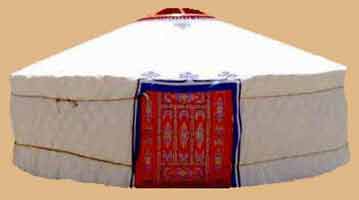 |
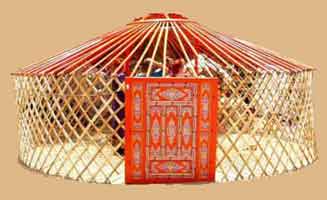
Shell with worm fence |
 |
|

Pole for roof cornice |
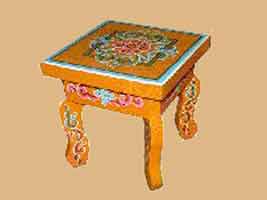
Stool |
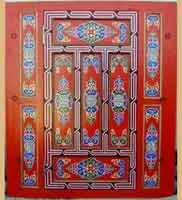
Door always to face South |
|
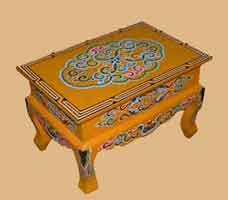
Table |

Buddhist shrine |

Chest |
|
|
|
| Tungus Tshum (Urts)
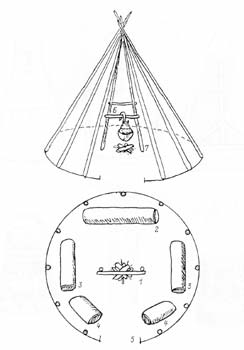
|
up: |
|
Seran - Poles, Framework of a tshum |
|
|
|
below:: |
| 1. |
Togoo - Fire place (golomti) with transverse pole and attachment device (Ikeptun) for cauldron (toogois) |
| 2. |
Malu - Seat of honour of the owner and his guests |
| 3. |
Be - Place for family members |
| 4. |
Tchona - Place for tools and devices |
| 5. |
Urkh - Entrance, door opening |
|
Kazakh Kiis-Uj
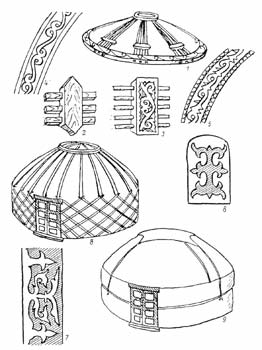
| 1. |
Upper ring, roof cornice |
| 2. |
Detail of the support and ordering strips |
| 3. |
Detail of the transverse strips to the cornice strips |
| 4. |
Pattern of the upper ring for cover |
| 5. |
Pattern of the ring to the order stripe |
| 6. |
Pattern of the filt for side cover |
| 7. |
Pattern of the upper cove |
| 8. |
Shell of a "Kiis-Uj" - Yurt |
| 9. |
General plan |
|
Mongolian Ger

| 1. |
Upper ring, roof cornice (tonoo) |
| 2. |
Brace to the roof cornice |
| 3. |
Worm fence made from pliable wood |
| 4. |
Door, always facing South |
| 5. |
Bottom support for roof cornice |
| 6. |
Floor made from wood or carpet |
| 7. |
Upper cover, often several felt layers, according to weather, in winter up to four layers |
| 8. |
Side cover |
| 9. |
Cover of the upper aperture wreath |
| 10. |
Belt made from yak or camel hair
|
| 11. |
General plan |
|
|
|
Further nomadic dwellings |
|
|
Kohta - Cota - Sami tent. This is a round and transportable tent, the Lapp reindeer nomads use as site-independent dwelling. There are cotas for summer and for winter, respectively. They differ from each other in their use of materials, this is use of reindeer skins in summer and mud or stone in winter. |
| Tipi - Tent of the Red Indians in Northern America. |
 |
|
|
|
|
|
The Sacred Circle and the Ger (in Tengerism - Shamanism)
The ger (the original Mongolian term), or the yurt (in Russian), is the traditional dwelling of the Mongols and, in general, that of nomadic people in Central Asia. It is constructed of a framework made of poles (uni) radiating from a center smoke hole ring (toono), which is lashed on top of a circular latticework wall. Many Siberian tribes like the Tsataan, the Altai-Uryankhai and the Tungus (Evenks) are reindeer nomads who live in tshum, which is similar to the tipis or hooghan of the Navaho people in Southwestern North America. Anyway, orientation and symbolism of the ger are valid for all Mongolian groups. gers and tipis (yurts) are designed as to be easily assembled or taken down as the nomadic owner resumes his travel; the imagery and meaning of the ger, however, stays the same, no matter where it is being erected.
The ger is not only the center of the universe but also a microcosm within it. In fact, it is a map of the universe at large, and the vault of heaven is reflected in the arched shape of the interior of the ger roof.
The entrance is always to face South, since that is the front of the ger. The North side, also called the hoimor and located behind the fire, is the most honourable spot in the ger (place of the shrines - altars). It is here that the sacred objects, ongon spirit dwellings and other religious images are placed on a table or chest. The sitting place next to the hoimor is the most honoured place, and it is occupied by elders, chiefs, shamans, or other respected guests. The Western side on the right is the male side, and thus it constitutes the sitting place for men and storage place for men’s tools, saddles, bows, and guns. The left and Eastern side is the sitting place for the women, and it comprehends the storage area for cooking utensils, cradleboards, and other women’s objects. Since the Southern side is the least honoured spot, young people are usually seated on the Southern part of the left and right sides.
Movement is "sunwise", i.e. in a clockwise direction. The reason why this is regarded as the path of the sun becomes readily apparent if one watches the track traced by the circular patch of sunlight entering through the smokehole through the day. Whenever moving inside the ger, one must always move in a sunwise direction. This same movement is also required in shamanic dances, worship, and ritual.
The center of the ger is the most sacred place of all, the gal golomt, the place of the fire. It is the dwelling place of the daughter of Father Heaven, Golomt, and it is to be treated with utmost respect. As the ger is the center of the world, so the place of the fire is the center of the universe represented by the ger itself. The vertical axis represented by the column of smoke rising from the gal golomt also represents the World Tree which shamans ascend to the upper world, the smoke ring (toono) corresponds to the gateway to the upper world. In some shaman rituals, such as the initiation of shamans, a tree will actually be erected extending from beside the gal golomt to beyond the smokehole. As the shaman ascends the tree in his ecstatic state, he describes his journey to the upper world. Also, even in the absence of the toroo tree (birch or willow), the shaman will still travel to other worlds after exiting through the smoke hole, often after his spirit has metamorphosed into a bird.
The ger, therefore, can be seen as a parallel to the Native American medicine wheel, a physical representation of the sacred circle with a definite orientation towards the four directions and the universe at large. The circular pattern and alignment towards the four directions is also retained in outdoor shamanist ceremonies, such as the walking and dancing around the sacred ovoo (hill) cairns erected for the mountain spirits, or the yokhor dance (circle dance) around a toroo tree by means of which the dancers raise a spiral of energy to carry the shaman to the Heavens. Sunwise circular movement is also used in the dallaga blessing ceremony and in all types of shamanistic dances performed by the shaman.
- see more information about: Shamanism in Mongolia (Tengerism)
|
|
| - see more information about yurts - project.yourtent.com |
| - see information about yurts in Scotland - highland yurts |
|

PageTop

|
|
